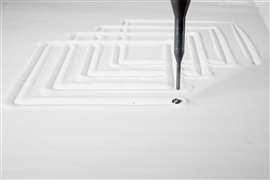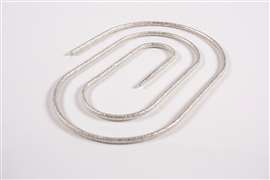How rapid 3D metal printing breakthrough could prove useful in construction
05 February 2024
Researchers at the Massachusetts Institute of Technology (MIT) have declared a breakthrough in additive manufacturing that allows them to 3D print liquid much more rapidly.
And they have claimed that the new technique, called liquid metal printing (LMP), could find a use in architectural and construction applications.
Skylar Tibbits, associate professor in MIT’s Department of Architecture, who is senior author of a new paper on the technique told Construction Briefing, “Architecturally we are interested in any aluminum structure from exterior facade, fenestration and screens, to exterior detailing like railings, brackets and components, as well as interior detailing like shelves, screens and furniture.
“Aluminum is widely used in architecture since it is light, recyclable and easily workable. We likely wouldn’t be making structural components or rebar reinforcement since we aren’t printing with steel, but that could be a possibility in the future.”
LMP involves depositing molten aluminium along a predefined path into a bed of tiny glass beads. The metal hardens into a 3D structure in a process that researchers claim is 10 times faster than comparable additive manufacturing processes.
The 3D structure created in the printing process is then durable enough to withstand post-print machining such as milling and boring.
The researchers behind the process said in the new paper that within architecture and construction, welding arc additive manufacturing is one of the only metal additive techniques with the capacity to produce large-scale parts and that this process is limited by slow print speeds.
But there is a trade-off.
While LMP allows faster printing at scale, with print components larger than those typically made by slower additive techniques, it cannot achieve such high resolutions.
 The liquid metal printing process involves depositing molten aluminum along a predefined path into a bed of tiny, glass beads (Image: MIT Self-Assembly Lab)
The liquid metal printing process involves depositing molten aluminum along a predefined path into a bed of tiny, glass beads (Image: MIT Self-Assembly Lab)
That makes adding fine details difficult. But the MIT researchers argued that this still made it suitable for some construction applications. In the paper, they said, “Liquid metal printing is conceptually similar to free-form casting, where a large amount of metal is melted and rapidly dispensed along a predefined toolpath in order to produce a 3D form.
“The building sector accounts for roughly one third of global energy and process emissions. Among the materials produced in excess of one million tonnes per year, the vast majority are used for structural purposes, including concrete, steel and aluminium.”
They argued that this means the lifetime of a material needs “substantial consideration” and that 3D printing in aluminium could offer environmental benefits due to the “potentially high metal retention between casting and re-casting in its recycling”.
Advantages over WAAM
Prof Tibbits said, “This is a completely different direction in how we think about metal manufacturing that has some huge advantages. It has downsides, too. But most of our built world — the things around us like tables, chairs, and buildings — doesn’t need extremely high resolution. Speed and scale, and also repeatability and energy consumption, are all important metrics.”
The researchers also claimed that the new technique has an advantage over wire arc additive manufacturing (WAAM), already making its way into construction and architecture applications, which allows the production of large, low-resolution structures.
They said that whereas WAAM structures can be prone to cracking and warping because some portions have to be remelted during the construction process, LMP keeps material molten throughout the process, avoiding some of those structural issues.
How it works
 The LMP process can enable the printing of complex geometries, like the spiral seen here. (Image: MIT Self-Assembly Lab)
The LMP process can enable the printing of complex geometries, like the spiral seen here. (Image: MIT Self-Assembly Lab)
The LMP process works by depositing bread loaf-sized pieces of aluminium into an electric furnace and heating them to 700C. The aluminium is held in a graphite crucible and fed through a ceramic nozzle into a print bed along a preset path. But injecting the molten material into a granular substance, the researchers don’t need print supports to hold the structure as it takes shape.
Lead author Zain Karsan, who is now a PhD student at ETH Zurich, added, “Our process rate is really high, but it is also very difficult to control. It is more or less like opening a faucet. You have a big volume of material to melt, which takes some time, but once you get that to melt, it is just like opening a tap. That enables us to print these geometries very quickly.”
As they develop the technology, the researchers want to enable more consistent heating in the nozzle to prevent material from sticking and also to achieve better control over the flow of molten material.
STAY CONNECTED



Receive the information you need when you need it through our world-leading magazines, newsletters and daily briefings.
CONNECT WITH THE TEAM








